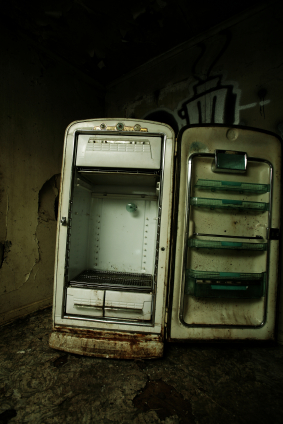Help the Climate: Empty the Fridge
Yesterday, I reported that in hopes of slowing down global warming, some nations were interested in strengthening the Montreal Protocol – a United Nations treaty to curb releases of chemicals that endanger stratospheric ozone. But I didn’t really get into what they had up their sleeves. It turns out they want signatory nations to eliminate a loophole: a failure to regulate coolants in existing refrigerators and air conditioners and the fluffing-up constituents of some plastic foams.

Old fridges, A/C units, and foam all tend to get sent to landfills or other graveyards of past-their-prime appliances and furniture. Many of these still contain ozone-destroying chemicals, or ODCs, that will eventually leak out and ascend to the stratosphere. Late last week, the Federated States of Micronesia and Mauritius formally urged Montreal Protocol officials to extend the treaty’s regulations to ODCs in old appliances and other products.
Globally, these products are estimated to represent a reservoir of chlorofluorocarbons and related chemicals with a climate-warming potential equal to some 7 billion tons of carbon dioxide. It’s not hard to imagine that these CFCs and other ODCs could escape into the environment by 2015, representatives of the two island nations argued.
Of course, both countries have a vested self interest in taking the lead on this issue. They’re among societies at risk of being submerged in the not-too-distant future if the current global-warming trend continues and fosters a substantial sea-level rise. They’re just floating the idea of the new measure. At the earliest, treaty negotiators wouldn’t take up the issue much before the end of the year.
Last September, both nations collaborated with colleagues in Argentina, Brazil, the United States, and a number of European countries in lobbying aggressively, and effectively, to speed the phaseout of hydrochlorofluorocarbons, better known as HCFCs.
At least in terms of the environment, HCFCs were deemed somewhat healthier chillers than CFCs. The reason: Although they’re ODCs, the greenhouse-gas potency of HCFCs is not nearly as high as is that of conventional chlorofluorocarbons, such as Freon. However, scientists working for the Montreal Protocol learned that HCFCs were being substituted for nastier ODCs at higher than expected rates.
New analyses undertaken for the Montreal Protocol administrators indicated that industrial use of HCFCs could total 700,000 metric tons by 2015, or five times more than had been projected a decade earlier. That’s according to a March report by Donald Kaniaru, a former UN Environment Program official stationed in Nairobi; Rajendra Shende, a current UNEP official based in Paris, and Durwood Zaelke, president of the Institute for Governance & Sustainable Development, headquartered in Washington, D.C.
The anticipated climate benefit of the speeding the HCFC phaseout is a whopping 16 billion tons of carbon dioxide equivalent by 2040. That’s several times the overall CO2-mitigation goal being sought by negotiators of the Kyoto Protocol, the treaty set up explicitly to protect Earth’s climate.
“We know we are getting close to the point-of-no-return for abrupt climate change from the melting of the Arctic Ice and disintegration of the Greenland Ice Sheet,” observes Sateeaved Seebaluck, an environment official in Mauritius. “And we know that one of the best ways to slow this down is to strengthen the Montreal Protocol.”
Tonight, EPA presented its 2008 Climate and Ozone Layer Protection Awards at a KennedyCenter ceremony here in Washington. Among the winners were Zaelke and foreign leaders who played a critical role in spearheading the HCFC-phaseout (which began this month).






